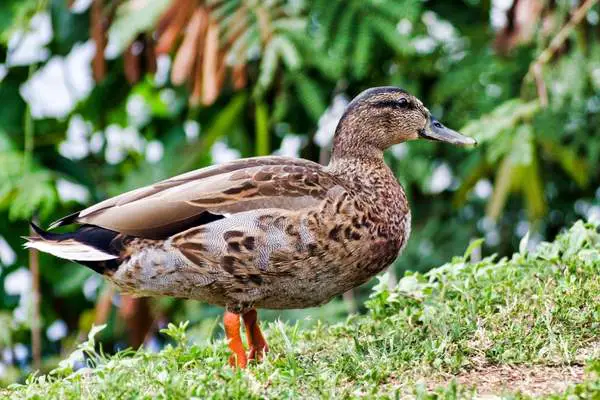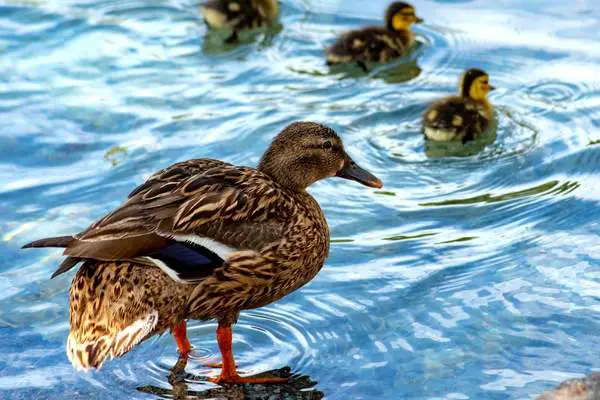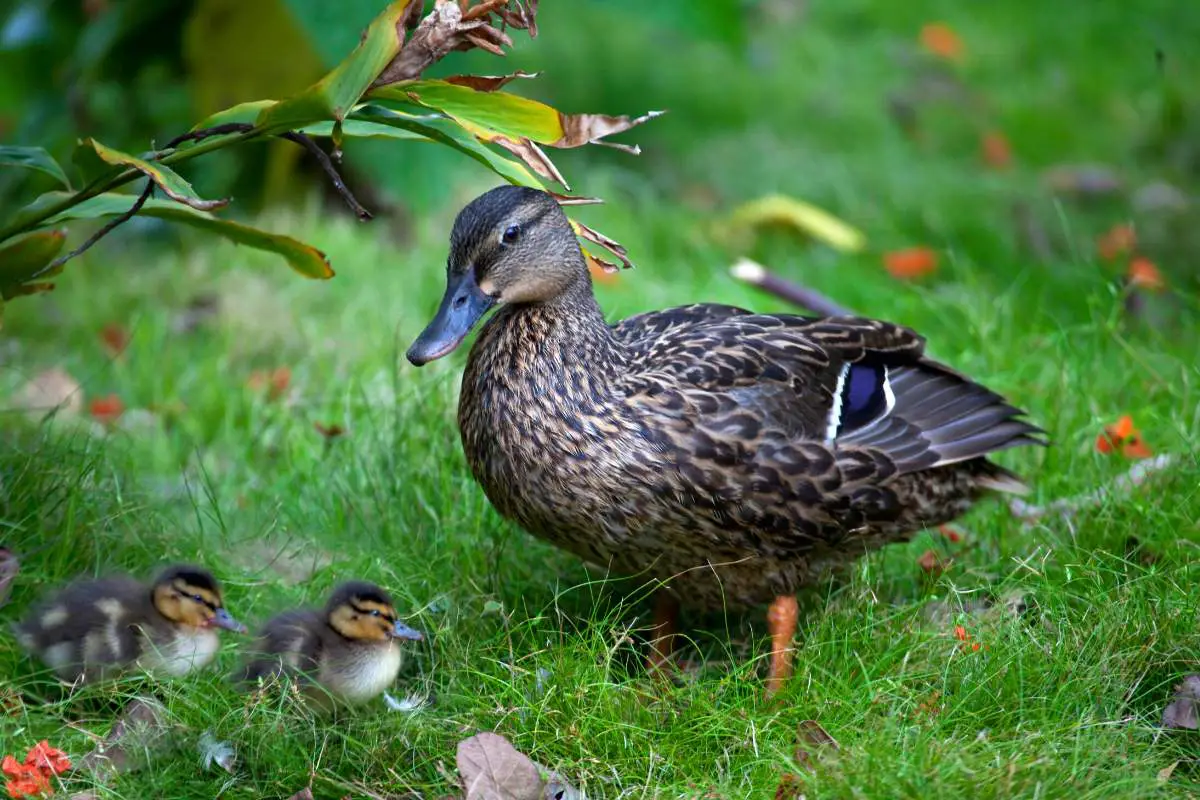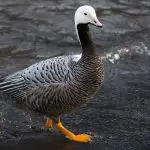Common Name: Hawaiian Duck
Scientific Name: Anas wyvilliana| Size | Diet | Range in Hawaii | Status in Hawaii |
|---|---|---|---|
| 18 in. - 24 in. | seeds, fruit, insects, snails, and other small invertebrates | Kauai, Oahu, Molokai, Lanai, Maui, and Big Island | Endangered |
The Hawaiian duck (Anas wyvilliana), also known as the koloa, is a species of duck that is native to the Hawaiian Islands. It is thought to be descended from the mallard, and it is closely related to the Pacific black duck.
Hawaiian Duck
Appearance

The Hawaiian duck is a medium-sized duck with a distinctive appearance. It has a dark brown head and neck, with a lighter brown breast and belly.
The wings and back are a dark, iridescent green color, and the legs and feet are orange. These are medium-sized ducks that measure between 18 and 24 inches in length and weigh between 1.5 and 2.5 pounds.
The male Hawaiian duck has a green speculum (a brightly colored patch on the wing) and a white ring around the base of the bill. The female is similar in appearance, but she is slightly smaller and lacks the male’s bright wing patch. Both males and females have a blue-gray bill and a white ring around the base of the bill.
Diet
Hawaiian ducks are omnivorous, which means they eat a wide variety of plant and animal matter. In the wild, they feed on seeds, fruit, insects, snails, and other small invertebrates. They are known to forage in both wetland and upland habitats, and they will also occasionally feed on agricultural crops such as rice and sugarcane.
Behavior
Hawaiian ducks are social birds and are often found in small flocks. They are most active during the day and spend their time foraging for food, preening their feathers, and resting. They are also strong swimmers and divers and can be seen swimming and diving underwater in search of food.
Hawaiian ducks are territorial during the breeding season and will defend their territory against intruders. They are known to be vocal birds and make a variety of calls, including quacks, whinnies, and honks.
Nesting
Hawaiian ducks build their nests on the ground, often near water, and line the nest with feathers and other soft materials. The female Hawaiian duck typically lays a clutch of 5-10 eggs, and she alone incubates the eggs for an average of 30 days. The male usually remains nearby to defend the nest and the female while she is incubating the eggs.
Once the eggs hatch, the female leads the ducklings to water and helps them learn to swim and forage for food. The ducklings are able to fly at about 8-10 weeks of age.
Habitat

They inhabit a variety of habitats, including wetlands, grasslands, and forests. They are most common in areas with a mix of wetland and upland habitats, as this provides them with access to a variety of food sources.
Range
Hawaiian ducks are found throughout the Hawaiian Islands. They are native to all of the main islands, including Kauai, Oahu, Molokai, Lanai, Maui, and the Island of Hawaii. They are also found on a number of smaller islands, including Kure Atoll, Midway Atoll, and Laysan Island.
Conservation Status
The Hawaiian duck is listed as an endangered species by the International Union for Conservation of Nature (IUCN). This means that it is at high risk of extinction in the wild.
Interesting Facts
1. Koloa maoli
The native Hawaiian name for this duck is koloa maoli which means “native duck”, or simply koloa.
2. Hawaiian duck has been a guide to Imaikalini
Due to legends of Hawaii, the Hawaiian duck has been a guide to Imaikalini, a fierce blind warrior king. It is said that when the warrior king went into battle, the ducks would guide him to the presence of his enemies; they were quacking to indicate their location.
3. They are adapted to the tropical climate of Hawaii
Hawaiian ducks are adapted to the tropical climate of Hawaii and are found at elevations ranging from sea level to over 4,000 feet.
4. Important culture symbol in Hawaii
The Hawaiian duck is an important cultural symbol in Hawaii, and it is featured in traditional stories and legends of the Hawaiian people. It is also depicted in traditional Hawaiian art and is considered a symbol of good luck.
5. They have unique physical adaptations
The Hawaiian duck has a number of unique physical adaptations that are well-suited to life on the Hawaiian Islands. These include a long and slender bill, which is adapted to extracting insects and other small prey from crevices and cracks, and elongated central tail feathers, which are used for balance and maneuverability on land.
Frequently Asked Questions:
Are Hawaiian ducks protected?
The Hawaiian duck is an important cultural and ecological resource in Hawaii, and it is protected by the state.
Is Hawaiian duck a strong flyer?
Hawaiian ducks are capable of flying, but they are generally not considered to be strong fliers. Hawaiian ducks are adapted to life on the ground in their natural habitat, where they forage for food and nest. They are more agile and quick on land than in the air, and they are known to be good runners and swimmers.
How do Hawaiian ducks communicate with each other?
Like other duck species, Hawaiian ducks likely use a combination of vocalizations and body language to communicate with each other. They are known to make a variety of sounds, including quacks, honks, and whistles, which they use to communicate with other ducks.
The specific sounds that a duck makes can vary depending on the situation, and may be used to communicate a range of information, such as alarm, aggression, or interest in mating.
How did Hawaiian ducks become endangered?
One major factor is habitat loss. Hawaiian ducks are adapted to living in wet forests and other areas with dense vegetation, and their natural habitat has been greatly reduced by human activities such as agriculture, development, and logging.
Another factor is the introduction of non-native species, which can compete with Hawaiian ducks for resources and also prey upon them. Rats, for example, have been introduced to the Hawaiian Islands and are known to prey on eggs and chicks of native bird species.
Other threats to Hawaiian ducks include diseases, predation by domestic animals, and the effects of climate change. The small population size of Hawaiian ducks also makes them vulnerable to extinction due to random events, such as natural disasters.




